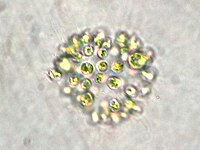
Photo from wikipedia
The ability of Microcystis to form large colonies is a key trait that contributes to competition ability over other phytoplankton and facilitates the formation of surface scums in many freshwater… Click to show full abstract
The ability of Microcystis to form large colonies is a key trait that contributes to competition ability over other phytoplankton and facilitates the formation of surface scums in many freshwater systems. The effect of temperature and nutrients on this trait, however, is far from clear and needs further investigation, especially under a warmer climate and nutrient overloading in aquatic systems globally. In this study, two colonial strains of Microcystis (M. wesenbergii and M. ichthyoblabe) originally isolated from Lake Taihu in China, were used to investigate cyanobacterial aggregation under a range of temperatures (15-30 °C), phosphorus availability (0.004-8 mg P L-1), and nitrogen availability (0.04-40 mg N L-1). The mechanism of colony formation in Microcystis was determined based on growth rates and extracellular polysaccharide (EPS) contents. The colony size of both strains increased significantly when the temperature rose from 15 to 25 °C. A further increase in temperature from 25 to 30 °C, however, reduced the colony size of M. ichthyoblabe significantly, and, in contrast, increased the colony size of M. wesenbergii. Higher phosphorus availability promoted the formation of larger colonies in both strains. In comparison, nitrogen had no significant effect on the colony size. Furthermore, although EPS was a significant contributor to the formation of large colonies in colonial Microcystis, growth rate was a dominant driving factor in this process. The findings of this study highlight that warmer temperatures and phosphorus enrichment might enhance surface Microcystis scums directly through increasing the colony size. This study also provides new insights into the mechanism of colony formation in Microcystis.
Journal Title: Harmful algae
Year Published: 2018
Link to full text (if available)
Share on Social Media: Sign Up to like & get
recommendations!